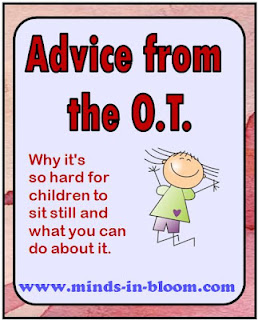...and What You Can Do About It!
 |
| Add caption |
Minds in Bloom is so very honored to welcome guest blogger Loren Shlaes, a registered pediatric occupational therapist and regular contributor to the special needs blog at Pediastaff. This is the first in a series of post from Loren about how to help students who may be challenged with attention, sensory, or other issues be successful in the classroom. Most likely, you have at least a few students with these challenges every year, but even if you don't, the information in these posts are relevant to all teachers.
This first post focuses on something that most teachers struggle with around this time of the year...helping students to pay attention! I learned a great deal from this article, and I am sure you will too!
Children need to move their bodies in order to be able to stay focused and to learn. A good thing to remember is that a nerve in the inner ear, called the vestibular nerve, serves to tell the body how upright, aroused, and present to be in direct response to movement. The only way to activate the vestibular nerve so that it can do its job is to move.
Normally, a small amount of movement, like a quick stretch and turn of the head, will make the nerve fire and talk to the muscles. When children are fidgeting and finding it difficult to stay still, they are unconsciously attempting to activate that nerve in the inner ear to improve their ability to sit up and focus.
Are Your Students in the Just Right State or in a Sensory Needs State?
When we are forced to sit still for long periods, we are either in one of two states: the just right state, meaning that our bodies can support our ability to stay present by remaining effortlessly aroused and upright, or in a sensory needs state, which means that we cannot attend because our bodies need something to help our brains stay alert and ready to learn. The just right state doesn't last long when we are forced to sit without moving, unless what is happening in the room is highly interesting and engages our full attention. Attention spans in young children are quite short. Most of the time, they require constant movement and novelty to stay engaged.
- play with a fidget toy
- suck a hard candy
- stretch
- squeeze and relax all of your muscles
- rub your hands on your legs
- give yourself a big hug
- quietly blow out all of your breath and hold it, then let the next breath come rushing in.
- For a child who needs to chew to stay grounded, a few inches of clear plastic fish tank tubing on the end of his pencil is easy and discreet. This can be easily and inexpensively purchased in a pet store or hardware store. If the child doesn't like the flavor, you can soak it in vanilla extract for a day or two.
 Disc-O-Sit cushions are another very nice way for a child to be able to sit still at his desk and wiggle around at the same time. Making a few cushions available for anyone who wants them will allow the children who really need them to gravitate towards them without feeling singled out.
Disc-O-Sit cushions are another very nice way for a child to be able to sit still at his desk and wiggle around at the same time. Making a few cushions available for anyone who wants them will allow the children who really need them to gravitate towards them without feeling singled out.Advice from the OT will appear on Minds in Bloom each Wednesday for the next six weeks. Next week's post will be about helping your students to attend during circle time.
 Loren Shlaes is a pediatric occupational therapist who specializes in sensory integration, handwriting remediation and school related issues. She is also a manual therapist and a certified teacher of the Alexander Technique. Her site won the "favorite resource for therapists" poll conducted by yourtherapysource.com. Her writing has been featured on Parents.com, and she is a regular contributor to the special needs blog at Pediastaff. She is in private practice in Manhattan.
Loren Shlaes is a pediatric occupational therapist who specializes in sensory integration, handwriting remediation and school related issues. She is also a manual therapist and a certified teacher of the Alexander Technique. Her site won the "favorite resource for therapists" poll conducted by yourtherapysource.com. Her writing has been featured on Parents.com, and she is a regular contributor to the special needs blog at Pediastaff. She is in private practice in Manhattan.
No comments:
Post a Comment